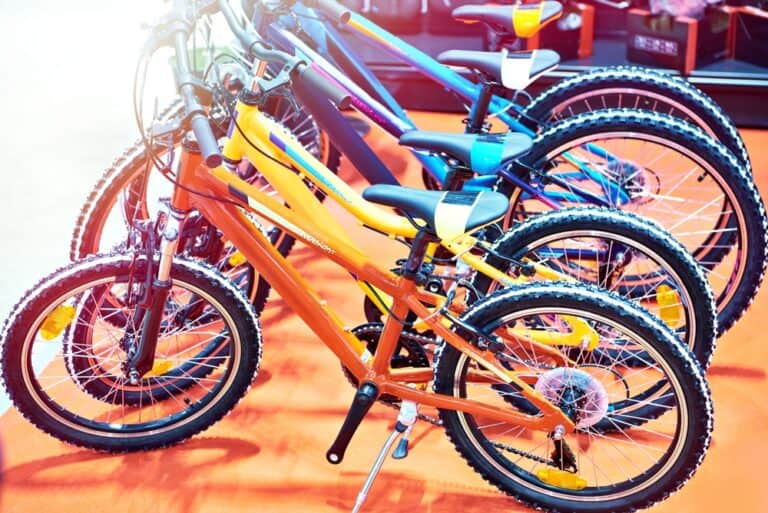Will I Go Faster On A Carbon Road Bike?

After a decade or so of avidly watching the Tour de France (TDF), I decided I was ready to tackle one of our local road races on my trusty hybrid bicycle. Unfortunately, I never considered the countless hills or fatigue I would encounter pedaling my steel steed for hours. By the finish, I was moving so slowly I could have walked faster, and I wondered, ‘Would I Go Faster On A Carbon Road Bike’?
Since carbon fiber is the lightest bike frame material commonly used today, it is far easier to pedal over long distances. The lighter bike will allow you to accelerate, climb and descend faster, offering superior wind resistance properties. You will go faster on a carbon road bike.
Bicycle frames have been constructed from various materials over decades, with steel being the first material employed for the frame. For several years, the main choice has been between carbon fiber and aluminum, with titanium also featuring, though steel is still used extensively, particularly in lower-end bicycles.
Each material carries pros and cons, and the choice will depend on your priorities as a rider, with a budget and weight the prime issues for most cyclists. The lighter you go, the easier to pedal and the higher the cost.
Will I Go Any Faster On A Carbon Road Bike?
Yes, you will, but there is a lot more to explore before spending the money on a high-end bicycle: Let’s consider the various material options available:
What Materials Are Most Often Used For A Road Bike?
There are four materials used in the construction of most bikes worldwide, with hugely differing costs and characteristics:
Steel
For the past hundred years, ‘Steel is Real’ was what bike manufacturers lived by, producing heavy, reliable bikes for everyone from delivery personnel to pro cyclists. In the mid-1990s, the pro tour experimented with aluminum and then started developing carbon fiber parts in an effort to emulate race cars and bikes.
Initially, frames were either lugged or welded, with lugs appearing more seamless and welding leaving the bike slightly lighter, with less excess material left at the site of each joint. Many manufacturers felt that a brazed joint caused less change to the steel’s properties than a welded joint which required higher work temperatures.
Performance-minded steel bikes are typically made from Chromoly steel, while high-tensile steel is often used to produce cheaper, entry-level frames. Curiously, stainless steel, while considered incredibly strong, is on average weaker than Chromoly steel, though specialist stainless steels have been developed for bikes.
Steel Bike Frame Pros:
- Durable and won’t fatigue
- Strong
- Easily repaired
- Comfortable
- More affordable than other most materials
Steel Bike Frame Cons:
- Noticeably heavier
- More expensive than aluminum
- Will corrode unless properly treated
Titanium
Like aluminum and steel, titanium is an alloy, and the AL3 2.5V alloy (containing 2.5% vanadium and 3% aluminum) is the standard grade used for titanium frames, which are highly fatigue resistant.
Since a titanium tube is around half the weight of a steel tube of similar tensile strength, it can be lighter while still having a thicker-walled tube. This makes it harder to dent, and scratches are not an issue since it does not rust. Just as well, as it is the most expensive material used for bike frames.
Titanium Bike Frame Pros:
- Durable, strong and will not fatigue
- Lighter in weight than steel
- Improved ride quality
- The finish can be painted or left raw
Titanium Bike Frame Cons:
- Difficult to work with
- Heavier than carbon or high-grade aluminum
- Expensive to use

Aluminum
Often used interchangeably with carbon fiber or steel, aluminum is lighter than steel but heavier than carbon. It is stiffer than steel in its design, meaning less shock absorption on the road and less comfort for riders. Aluminum is widely used on recreational and racing bicycles today because it has a good strength-to-weight ratio.
As manufacturing processes and designs improve, the large tube sizes and high price tags of the past have come down somewhat, making aluminum a good choice for the average rider demanding a light, comfortable and solid ride.
Carbon Fiber
Lance Armstrong catapulted carbon fiber bikes into the public’s imagination in 1999, and the industry has never looked back. A carbon fiber bike frame consists of layers of fiber laid like pasta layers in lasagna and embedded in epoxy resin. The carbon fibers give it incredible strength while it is held together by the resin.
The strength-to-weight ratio of carbon is extreme, but only in one direction, hence the need for multiple-angle layering, which produces the strength without losing any noticeable weight benefit. Once the various layers in the frame have been assembled (a process done by hand,) it is placed in a metal mold and heated under pressure, thus bonding the various layers together.
Another important factor in carbon bikes is the modulus of which specific carbon fiber is used. Fibers with a higher modulus will be somewhat stiffer and more brittle. Thus, even a frame sold as ‘high modulus’ will be formed of a mix of different grades of carbon fiber. Higher modulus carbon fiber is also more expensive, but the result will be a lighter frame of the same strength.
Returning to our original question for a moment, you will certainly go faster on a carbon road bike because it is far lighter to pedal and thus will require less energy to propel you forward at speed, both up and downhill.
However, as with any ‘miracle’ material, it’s not all roses in the carbon household: The price is very high compared to other bike materials, and an aluminum option can offer certain similar – or improved – ride characteristics at a lower price.
Carbon fiber does not allow you to ream or tap it if you wish to have a threaded area for added components, so a metal insert may need to be added to house a threaded bearing. This adds weight and defeats one object of opting for carbon in the first place.
Carbon Fibre Bike Frame Pros:
- Superb stiffness-to-weight ratio
- Carbon is highly adaptable
- It can be easily molded into various aerodynamic shapes
Carbon Fibre Bike Frame Cons:
- Still very expensive
- Bang and bump damage not often visible – ultrasound may be required for assessment.
Conclusion
You can (and will) ride faster on a carbon road bike, and if that chiefly concerns you and you can justify the price, go ahead. However, occasionally, if you are riding competitively, there will be mishaps, accidents, etc., and a team with deep pockets is highly recommended if you plan to take this route.







